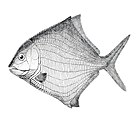Cornuboniscus
| Cornuboniscus Temporal range:
| |
|---|---|

| |
| C. budensis fossil | |
| Scientific classification | |
| Domain: | Eukaryota |
| Kingdom: | Animalia |
| Phylum: | Chordata |
| Class: | Actinopterygii |
| Family: | †Cornuboniscidae White, 1939 |
| Genus: | †Cornuboniscus White, 1939 |
| Species: | †C. budensis
|
| Binomial name | |
| †Cornuboniscus budensis White, 1939
| |
Cornuboniscus is an extinct genus of freshwater ray-finned fish that lived during the Pennsylvanian epoch (Carboniferous), and the only member of the family Cornuboniscidae.[2] It contains a single species, C. budensis from the Bashkirian/lower Westphalian age of what is now Cornwall, England.[1][3][4] The genus Cornubonisus was named after the island of Cornubian, and the species name refers to the coastal town of Bude in Cornwall. The type specimen is held in the town's Castle Heritage Centre.[5]
It was initially described as a palaeonisciform, a group of early ray-finned fishes that is now considered to be paraphyletic. On the basis of its paddle-like pectoral fins, it was initially recovered as a descendant of an early group of palaeonisciformes that also gave rise to the Tarrasiiformes and the extant bichirs. A later study instead found it as potentially being sister to the amblypterids and Acrolepis.[6][7][8][9]
Cornuboniscus was a small, sardine-sized fish with an array of razor-sharp teeth likely used to prey on small crustaceans.[10] It inhabited and was likely endemic to Lake Bude, a large, tropical, equatorial lake formed during the Variscan orogeny.[4][5][11]
References
[edit]- ^ a b Sepkoski, Jack (2002). "A compendium of fossil marine animal genera". Bulletins of American Paleontology. 364: 560. Archived from the original on 20 February 2009. Retrieved 24 April 2009.
- ^ Laan, Richard van der (11 October 2018). "Family-group names of fossil fishes". European Journal of Taxonomy (466). doi:10.5852/ejt.2018.466. ISSN 2118-9773.
- ^ "PBDB Taxon". paleobiodb.org. Retrieved 13 June 2024.
- ^ a b Higgs, Roger (1991). "The Bude Formation (Lower Westphalian), SW England: siliciclastic shelf sedimentation in a large equatorial lake". Sedimentology. 38 (3): 445–469. doi:10.1111/j.1365-3091.1991.tb00361.x. ISSN 0037-0746.
- ^ a b Turner, Mark (5 February 2024). "Bude's Geology". Visit Bude | Holidays in Bude | North Cornwall. Retrieved 13 June 2024.
- ^ Schultze, Hans-Peter; Mickle, Kathryn E.; Poplin, Cecile; Hilton, Eric J.; Grande, Lance (2021). Handbook of Paleoichthyology, 8A. Actinopterygii I. Palaeoniscimorpha, Stem Neopterygii, Chondrostei. Dr. Friedrich Pfeil, München. p. 299. ISBN 978-3-89937-272-4.
- ^ White, Erbol Ivor (1939). "A NEW TYPE OF PALAONISCOID FISH: 3. A new Type of Palaeoniscoid Fish, with Remarks on the Evolution of the Actinopterygian Pectoral Fins". Proceedings of the Zoological Society of London. B109 (1): 41–61. doi:10.1111/j.1469-7998.1939.tb00023.x. ISSN 0370-2774.
- ^ Nelson, Joseph S.; Grande, Terry C.; Wilson, Mark V. H. (22 February 2016). Fishes of the World. Wiley. ISBN 978-1-118-34233-6.
- ^ Dietze, Kathrin (2000). "A Revision Of Paramblypterid And Amblypterid Actinopterygians From Upper Carboniferous–Lower Permian Lacustrine Deposits Of Central Europe". Palaeontology. 43 (5): 927–966. doi:10.1111/1475-4983.00156. ISSN 0031-0239.
- ^ "BBC - A History of the World - Object : Bude fossil fish". www.bbc.co.uk. Retrieved 13 June 2024.
- ^ Anderson, Lyall I. (1 January 1994). "Xiphosurans from the Westphalian D of the Radstock Basin, Somerset Coalfield, the South Wales Coalfield and Mazon Creek, Illinois". Proceedings of the Geologists' Association. 105 (4): 265–275. doi:10.1016/S0016-7878(08)80179-4. ISSN 0016-7878.








